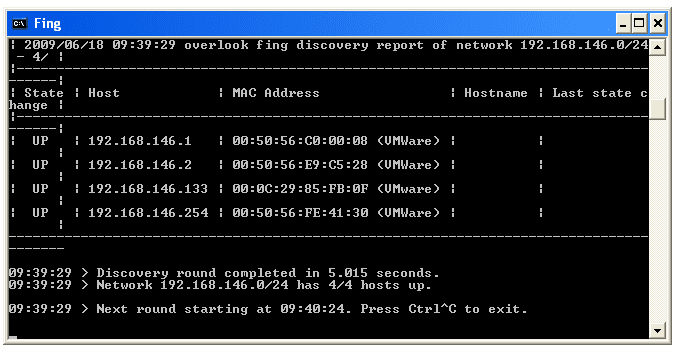
- #FING FOR MAC COMMAND LINE MAC OS X#
- #FING FOR MAC COMMAND LINE FULL#
- #FING FOR MAC COMMAND LINE FREE#
#FING FOR MAC COMMAND LINE FULL#
cfg file from the current directory if full path is not specified.

Custom context menu: You can now add your own menu items to the right-click context menu, by editing the configuration file (WNetWatcher.cfg).although this utility is officially designed for wireless networks, you canĪlso use it to scan a small wired network.In rare cases, it's possible that Wireless Network Watcher won't detect theĬorrect wireless network adapter, and then you should go to 'Advanced Options' window (F9),Īnd manually choose the correct network adapter.This utility can only scan a wireless network that you're currently connected to.This utility works on Windows 2000, Windows XP, Windows Server 2003/2008, Windows Vista, Windows 7, Windows 8, and Windows 10.To the clipboard and then paste into Excel or other spreadsheet application. You can also export the connected devices list into html/xml/csv/text file, or copy the list Is displayed: IP address, MAC address, the company that manufactured the network card, Wireless Network Watcher is a small utility that scans your wireless networkĪnd displays the list of all computers and devices that are currently connected toįor every computer or device that is connected to your network, the following information NK2Edit - Edit, merge and repair the AutoComplete files (.NK2) of Microsoft Outlook.WakeMeOnLan - Turn on computers on your network with Wake-on-LAN packet.WhoIsConnectedSniffer - Detect who is connected to your network without scanning.WifiChannelMonitor - Monitor access points and wifi clients in your area (Monitor Mode).Those apps will, if possible, list off friendlier device names (in addition to IP addresses) than arp -na offers.

#FING FOR MAC COMMAND LINE FREE#
There are iOS apps for the same purpose, like the free Fing and the $3 LAN Scan. One such app, iNet, is available on the Mac App Store. You can also turn to multiple third-party apps.

You won’t necessarily see friendly names for the devices it finds, but you’ll at least get a list of all the local IP addresses in use that it discovers. In Terminal, you can use the arp -na command, which will list out devices it finds using the address resolution protocol. So if you want to find the IP addresses of other devices connected directly to your base station, you might prefer another option.
#FING FOR MAC COMMAND LINE MAC OS X#
You can stil grab the old version of the utility from Apple, though you need a little help to install the app on Mountain Lion, since the installer (falsely) reports that AirPort Utility 5.6 is incompatible with Mac OS X 10.8.īut while you can force AirPort Utility 5.6 to install on Mountain Lion, there’s no guarantee that the app will continue to work on OS X 10.9 Mavericks or beyond. There’s no way to use the app to list off the IP addresses and names of devices plugged directly into the base station. AirPort Utility 6.x, however, only lists devices connected to your base station over Wi-Fi. AirPort Utility 5.6 could show you all the devices connected to your AirPort base station-wired and wireless alike.


 0 kommentar(er)
0 kommentar(er)
